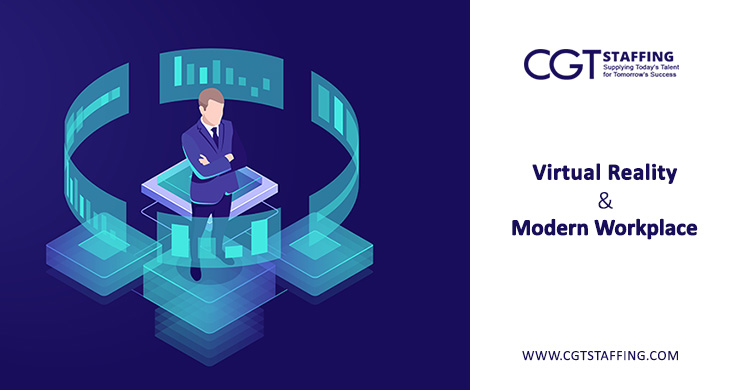Virtual reality technology and its many applications are slowly but steadily making their way into the mainstream. Known as “VR” for short, it has evolved exponentially since its early days as a video game technology. In fact, in the same vein that smartphones became a mainstay feature of everyday life (both personal and professional), VR holds the potential to have a huge impact on our lives, and how we work. This blog explores how virtual reality is already beginning to disrupt the workplace.
Table of Contents
How VR is Changing the Modern Workplace
There is no mistaking the fact that VR has already begun to trickle into the workplace. Tech-prioritizing businesses keep finding new ways to make virtual reality a part of everyday use. With efficient IT staffing assistance in getting the right talent, more businesses can find ways to incorporate VR into their workplace, such as the following:
- Better Growth and More Jobs
- Improved Interaction and Communication
- Simulation and Training
Let’s take a closer look at these below.
Better Growth and More Jobs
The immersive nature of virtual reality technology has a number of obvious applications, not the least of which are applications in advanced design and testing. Dynamic 3-dimensional simulation and visualization environments can help organizations train workers on sophisticated procedures or equipment without unnecessary risk.
3-D simulations of prototypes can be tested and showcased in such environments, which will soon become a crucial design skill in the future.
The immersive qualities of VR impact a plethora of business functions. Certain branches of any business – customer service, for example – depend on their ability to connect with customers and resolve their problems accordingly. A virtual environment where a business can interact with clients and customers leaves a more lasting impression and can even be a viable solution given the current COVID-19 pandemic.
As VR technology continues to evolve businesses will necessarily have to enlist the talents of experienced developers, programmers, designers, and other technical professionals. This specialized talent pool will effectively shape the future of virtual reality in the workplace.
Improved Interaction and Communication
The high-speed internet industry has expanded immensely over the past decade, as all major telecom staffing agencies can attest. This revolution has forever impacted the way corporations and businesses communicate and operate.
Telecommuting, working on the go, video conferences, and instant messages are all aspects of technology that have disrupted the workplace, transforming it into its current form. Accordingly, VR holds the potential to bring about another massive shift in business communication and interaction.
Remote meetings and video conferences are two prime examples of the changing times. Rather than a 2-D screen, VR creates a 3-D space with many more enhancements and customization options. Users can personalize avatars and create experiences from the unique to the fantastical.
On a smaller scale, VR enables the space needed to set up a virtual workstation. This could potentially usher in a whole different meaning to working remotely. Employees could be anywhere in the world, without having to leave their virtual desks. Many VR workspace applications remove the need for a monitor altogether, offering unlimited space for organizing files and optimizing applications.
Simulation and Training
VR has deep roots in the gaming industry. With that in mind, it is not surprising that many organizations (NASA and the Air Force among them) already use virtual reality simulators to train employees on specialized equipment.
VR offers a high level of audio-visual immersion. This makes it the perfect conduit to simulate high-pressure and hyper-realistic situations – emergency surgery or airplane malfunctions, for instance – without actually putting anyone at risk. It can also be integrated into less stressful jobs, such as training of workers, technicians, and in-field engineers.
While VR is still maturing, it has quickly evolved beyond its early years as a gaming novelty. Virtual reality holds the potential to disrupt modern workplaces in a fashion not unlike the advent of digital technology. It is safe to assume that it will fuel industry growth and create new, advanced professional opportunities as more businesses adopt it.
The applications seem limitless, from conducting virtual interviews for mortgage staffing to training interns on virtual patients. These early days are a likely prelude to another major shift in workplace technology.
